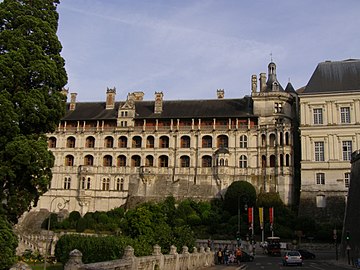Château of Blois
This article includes a list of general references, but it lacks sufficient corresponding inline citations. (April 2015) |


The Royal Château of Blois (French: Château Royal de Blois, pronounced
The château effectively controlled the County of Blois up to 1397, then the Duchy of Orléans, and the Kingdom of France between 1498 and 1544. It comprises several buildings, whose construction began in the 13th century and ended in the 17th century. Four different architectural styles are represented within the rectangular edifice, including: some remainings of the 13th-century medieval fortress, the Louis XII Gothic-style wing, the Francis I Renaissance-style wing, and the Gaston of Orléans Classical-style wing.[2] In total, there are 564 rooms, including 100 bedrooms with a fireplace in each, and 75 staircases (although only 23 were used frequently).
History

Counts of Blois
In 854, the Blois
The "Estates General Room" (Salle des États Généraux in French), built in the beginning of the 13th century, is one of the oldest seignoral rooms preserved in France, and is also the largest remaining civilian Gothic room of the country.[2] This room was used as a court of justice by the Counts of Blois and again in 1576 and 1588 during so-called Estates General.
Transition to the House of Orléans
The medieval castle was given in 1397 to
King Louis XII
At the beginning of the 16th century, King Louis XII initiated a reconstruction of the entrance of the main block and the creation of an Italian garden in terraced parterres where Victor Hugo Square stands today.
This wing, of red brick and grey stone, forms the main entrance to a proper château onwards, and features a statue of the mounted King above the entrance. Although the style is principally Gothic, as the profiles of mouldings, the lobed arches and the pinnacles attest, there are elements of Renaissance architecture present, such as a small chandelier.
King Francis I
When
-
The rear of the Francis I wing, facing over central Blois in the 1890s
-
The rear of the wing in 2007
-
The Château's most renowned feature, the spiral staircase in the Francis I wing
Since King Louis XII was very committed in the Italian campaigns, which imported the
King Henry III
Driven from


King Henry IV
After this, the castle was occupied by King Henry IV, the first Bourbon monarch. On Henry's death in 1610, it became the place of exile for his widow, Marie de' Medici, when she was expelled from the court of her son, King Louis XIII.[4]
Duke Gaston of Orléans
In 1626, King Louis XIII gave the
This wing makes up the rear wall of the court, directly opposite the Louis XII wing. The central section is composed of three horizontal layers where the superposition of Doric, Ionic and Corinthian orders can be seen.[6]
By the time of the French Revolution, the immense castle had been neglected for more than 130 years. The contents, many of its statues, royal emblems and coats of arms of the palace were removed. In a state of near-total disrepair, the Château of Blois was scheduled to be demolished but was given a reprieve as a military barracks.[5]
Preservation as a monument
In 1840, the initiative of Prosper Mérimée placed the château on the list of historical monuments.[7] This allowed state funds to be used in the preservation.[7] It was restored under the direction of the architect Félix Duban.[3]
The château is maintained and owned by the town of Blois and has been opened to the public as a museum and tourist attraction. On view for visitors are the supposed poison cabinets of Catherine de' Medici. Most likely this room, the "Chamber of Secrets", had a much more banal purpose: exhibiting precious objects for guests.[7]
People linked to the Château
People born in the Château
The following individuals were born inside the Château:
- Charles of Blois (in 1319);
- Louis XII (in 1462), King of France between 1498 and 1515;
- Marguerite Louise d'Orléans (in 1645), daughter of Gaston of Orléans.
People who died in the Château
The following individuals died within the Château:
- Anne of Brittany (in 1514), last Queen of Brittany, married Louis XII in 1499;
- Claude of France (in 1524), daughter of King Louis XII and Queen Anne of Brittany, married Francis I;
- Henry I of Guise (in 1588), 3rd Duke of Guise, assassinated after his participation to the Day of the Barricades;
- Louis II of Guise(in 1588), Duke of Guise's brother;
- Catherine de' Medici (in 1589), wife of King Henry II, was exiled in Blois by her son, King Henry III;
- Count of Blois.
See also
References
- ^ "Painting of Joan of Arc, Chateau de Blois, Loire Valley, Centre, France | Manuel Cohen". manuelcohen.photoshelter.com. Retrieved 19 September 2018.
- ^ a b [Anglais], Site Château de Blois. "Four architectural styles". en.chateaudeblois.fr. Retrieved 19 September 2018.
- ^ a b c d e f Kucera, Miroslav (25 July 2013). Chateau de Blois: Simple Guide. pp. 224–236.
- ^ a b [Anglais], Site Château de Blois. "Illustrious historical figures". en.chateaudeblois.fr. Retrieved 1 October 2018.
- ^ a b [Anglais], Site Château de Blois. "The historic periods". en.chateaudeblois.fr. Retrieved 1 October 2018.
- ^ a b c d e [Anglais], Site Château de Blois. "Four architectural styles". en.chateaudeblois.fr. Retrieved 1 October 2018.
- ^ a b c [Anglais], Site Château de Blois. "Rehabilitation". en.chateaudeblois.fr. Retrieved 20 September 2018.
External links
- Château de Blois - official site
- Château de Blois - The official website of France (in English)
- A gallery of over 100 high resolutions images of the Chateau de Blois taken in 2009 [1]
- High-resolution 360° Panoramas of Château de Blois | Art Atlas





